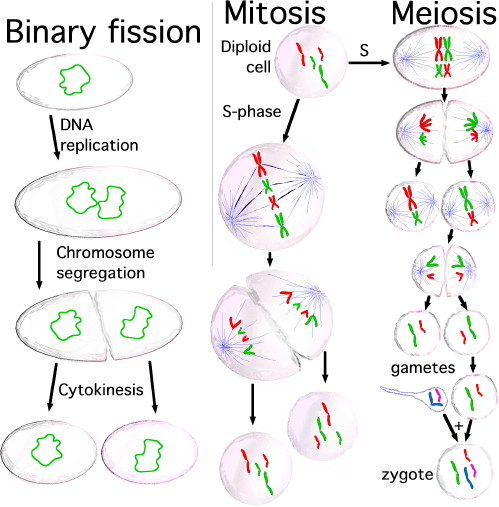
What is the difference between amitosis and mitosis?
Answer
498k+ views
Hint: Cells divide so that living things can grow. There are three ways for a cell to divide depending upon its type of cell- Amitosis, Mitosis and Meiosis. As we know mitosis finally results in division of parent alleles, whereas amitosis results in a random distribution of parental alleles. It does not involve the paired structures being pulled in opposite directions by a mitotic spindle in order to form daughter cells.
Complete answer:
Amitosis is also known by the name karyostenosis. It is also called direct cell division or also binary fission. It is basically a cell proliferation that does not occur by mitosis. The mechanism is essential for cell division in prokaryotes.
Whereas mitosis is a part of the cell cycle in which the replicated chromosomes are separated into two new nuclei. The major purpose of mitosis is to replace worn out cells and for growth.
Diagram below shows the difference in steps involved in amitosis or which is also called binary fission and mitosis.

Note:
Mitosis is also known as somatic cell division in which two identical cells are produced. This is because the cell is divided but the number of chromosomes remains the same and mitosis is a continuous process. Various phases like prophase, metaphase, anaphase, telophase, cytokinesis occur in mitosis. Amitosis takes place in a less developed cell of unicellular organisms and ultimately two new cells are formed.
Complete answer:
Amitosis is also known by the name karyostenosis. It is also called direct cell division or also binary fission. It is basically a cell proliferation that does not occur by mitosis. The mechanism is essential for cell division in prokaryotes.
Whereas mitosis is a part of the cell cycle in which the replicated chromosomes are separated into two new nuclei. The major purpose of mitosis is to replace worn out cells and for growth.
| Amitosis | Mitosis |
| Random distribution of parental alleles occurs. | Very precise division of parental alleles takes place. |
| In amitosis the nucleus divides, where each daughter nucleus receives chromosomes but they need not be equally distributed. | Chromosomes are more or less identically duplicated and equally distributed between the daughter cells. |
| Occurs in bacteria, blue-green algae, yeast, amoeba, protozoa. | Occurs in all animal cells, some plants like fungi and some algae. |
Diagram below shows the difference in steps involved in amitosis or which is also called binary fission and mitosis.

Note:
Mitosis is also known as somatic cell division in which two identical cells are produced. This is because the cell is divided but the number of chromosomes remains the same and mitosis is a continuous process. Various phases like prophase, metaphase, anaphase, telophase, cytokinesis occur in mitosis. Amitosis takes place in a less developed cell of unicellular organisms and ultimately two new cells are formed.
Recently Updated Pages
Why are manures considered better than fertilizers class 11 biology CBSE

Find the coordinates of the midpoint of the line segment class 11 maths CBSE

Distinguish between static friction limiting friction class 11 physics CBSE

The Chairman of the constituent Assembly was A Jawaharlal class 11 social science CBSE

The first National Commission on Labour NCL submitted class 11 social science CBSE

Number of all subshell of n + l 7 is A 4 B 5 C 6 D class 11 chemistry CBSE

Trending doubts
Differentiate between an exothermic and an endothermic class 11 chemistry CBSE

10 examples of friction in our daily life

One Metric ton is equal to kg A 10000 B 1000 C 100 class 11 physics CBSE

Difference Between Prokaryotic Cells and Eukaryotic Cells

1 Quintal is equal to a 110 kg b 10 kg c 100kg d 1000 class 11 physics CBSE

State the laws of reflection of light




